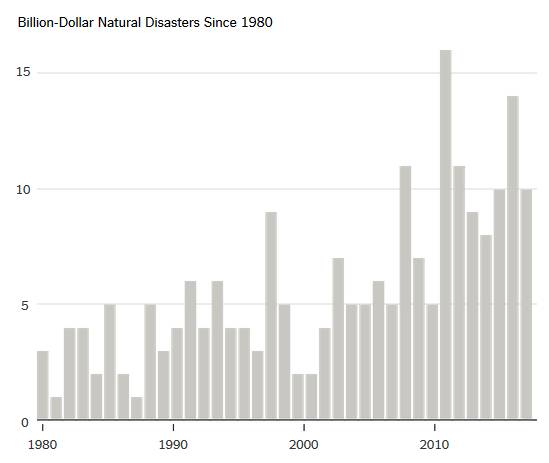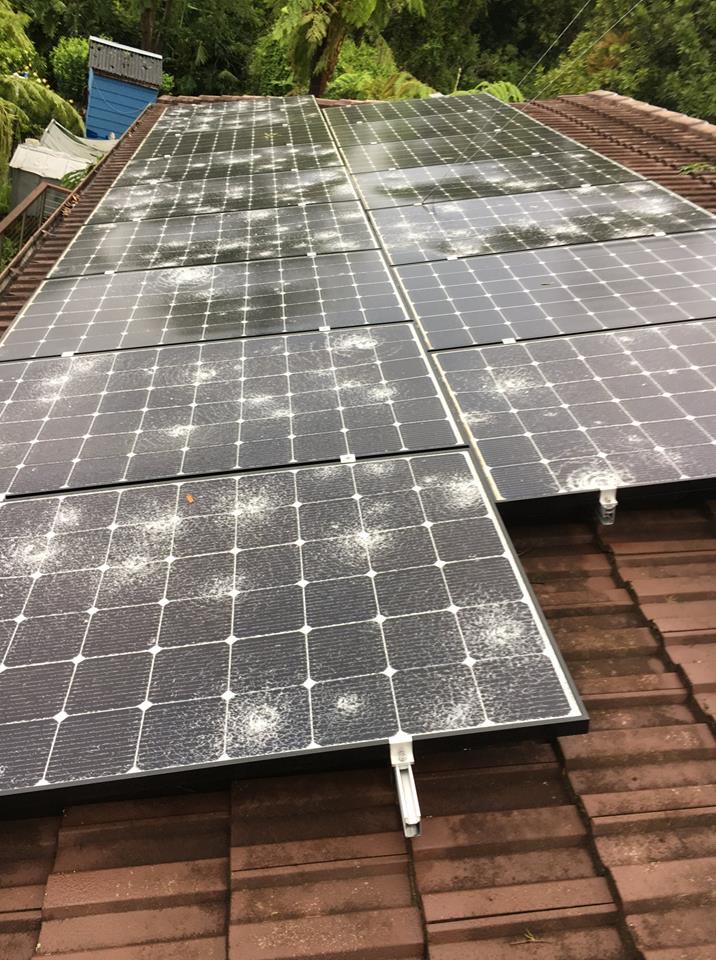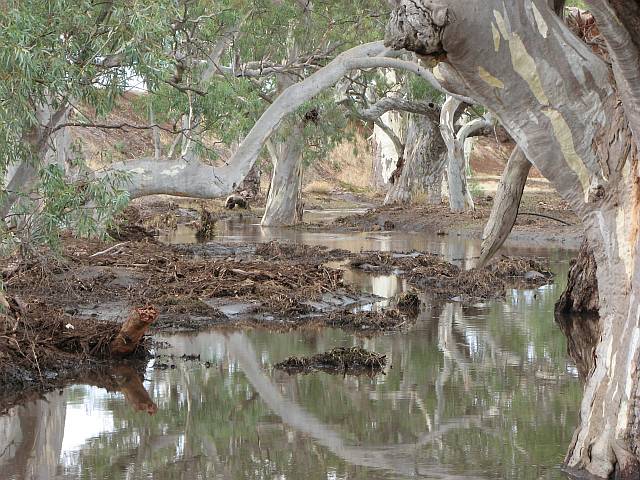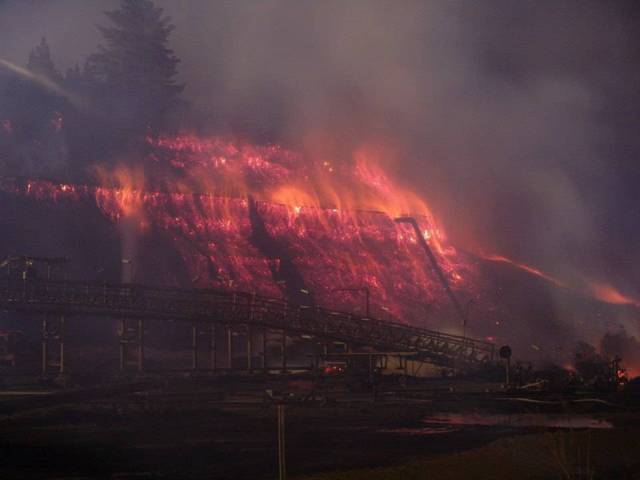| ||||
|
Hurricane Harvey, Texas, USA
An interesting graphic published in the New York Times (not shown on this page) shows all the billion-dollar-plus natural disasters since 1980. There have only been three that produced more than US$70b damage, and they have all been in the last twelve years. Billion-dollar-plus natural disasters are becoming much more common.Quoting from the New York Times 2017/09/03:
"Climate change is one reason for [increasingly frequent economic devastation from storms]: Global warming loads the atmosphere with more water vapour, which increases the potential for extreme rainfall events.The graph on the right shows the number of billion-dollar-plus natural disasters each year from 1980 to the present. The increase in frequency is obvious.
But the number of people and the amount of wealth in the United State are factors as well. As both population and wealth continue to concentrate along the coasts, storms have been increasingly likely to hit populated areas and development."
Monsoon floods in India, Nepal and Bangladesh
At the same time as Hurricane Harvey was flooding Texas, late August – early September 2017, a huge area of India, Nepal and Bangladesh was suffering from exceptional monsoon flooding; some 1200 people had been killed and the UN estimated that 41 million had been directly affected by the flooding; more about this in the New York Times.While the flooding in south-west Asia received far less media coverage in Australia than Hurricane Harvey, it was far more devastating. The death toll was at least 1200; 24 times that of Hurricane Harvey.
On 2017/09/07 it was reported that 5.9 million acres (2.4 million hectares,
24,000 square kilometres) of crops had been destroyed.
Wild-fires in Canada and USA
British Columbia, Canada
Global News reported about the worst recorded fires on record in British Columbia on 2017/09/05:"B.C. remains under a state of emergency as more than 100 wildfires continue to burn across the province. This season is now B.C.'s worst fire season in history and it is far from over.
Strong winds and record-setting heat across the province this weekend caused some fires to flare up, forcing more evacuation orders and alerts.
Thousands of British Columbians are still on evacuation order and about 12,000 remain on evacuation alert.
In addition, the provincial state of emergency has now been extended for a fourth time until end of day on Sept. 15."
Western USA
At the same time there were very bad fires in the USA, perhaps Oregon in particular. Oregon Governor Kate Brown said that officials have seen "unprecedented runs" in the Eagle Creek fire – 13 miles (21 km) in 16 hours. The Eagle Creek fire was just one of dozens burning at the same time.On 2017/09/06 The Atlantic reported that "dozens of forest and brush fires are currently burning across eight western states", and that "more than a million acres (4000 square kilometres) have burned in the past week alone".
|
|
Australia
Australia, like the rest of the world, was suffering from unprecedented 'natural' disasters that were almost certainly linked to climate change.
|
Hail damage December 2018
Unprecedented hail storms caused extensive damage in parts of Sydney. The hail stones were big enough to damage a great many cars, smash roofing tiles, and damage many rooftop solar panels.
For more information see
The Guardian, "Sydney storms: city battered by tennis ball-sized hail as fronts hit NSW coast".
Fires, January and February 2019
(Update, January 2020: There were far worse fires in Australia a year later. I have written more on bushfires/wildfires and climate change elsewhere on these pages.)Tasmania
Almost 200,000 hectares of mostly Tasmanian bush has been burnt out since the fires were started by lightning in late January 2019 according to Tasmanian Fire Service estimates.Forests that have rarely, if ever, burned previously had been burned. They would take hundreds of years to recover, if they recovered at all.
For more information see ABC on-line news, 2019/02/05.
NSW Fires
Shortly before writing this sentence (2019/02/16) the ABC was reporting "Tingha and Tabulam fire downgraded, residents in shock after bushfires destroy 20 homes in northern NSW."Bangor fire, South Australia, 2014
The Bangor fire, near my home in Crystal Brook, burned largely in steep inaccessible country for a month before being extinguished by heavy rains. The rain on the soil left totally bare by the fires caused terrible erosion.The photo on the right is of debris including soil and ash left in the Crystal Brook in the town of the same name. The upper parts of the Crystal Brook catchment were burned in the Bangor fire.
The native vegetation will recover to a large extent in a few years following a fire like this, but the soil will take hundreds or thousands of years to be replaced.
Increased frequency and ferocity of fires will be disastrous for Australia's fragile soils.
Other fires
Exceptionally hot weather and spontaneous combustion seems to have been responsible for the soil in a cattle yard catching fire in February 2019. When asked about this David Bowman, a professor of pyrogeography and fire science at the University of Tasmania, said:"... a changing climate was creating unusual fire events across the world.
We are seeing more and more unusual expressions of fire in the landscape.
Here in Tasmania, we've seen incredible dry lightning storms igniting dried-out vegetation, in Victoria an old disused lake bed used for dairy farming catching on fire, in Tasmania drained swamps catching on fire. So we are seeing unusual things, and this one [the soil in the cattle year] is an unusual case."
Queensland flooding, February 2019
At the time of writing the full costs had not been assessed, but one of Queensland's major cities, Townsville, had suffered from catastrophic flooding.On 2019/02/07 it was reported that 250 houses were damaged to the point of being uninhabitable, another 750 had been severely damaged and up to 20,000 homes were "believed to have sustained some water impact". By 2019/02/08 it was being reported that insurers had received 11,800 claims with losses estimated at $147 million (Reinsurance News).
News was still coming out on 2019/02/09 about losses of huge numbers of cattle (300,000 has been mentioned) in the big grazing districts of Queensland.
According to an article written by Associate Professor Jacky Croke on The Conversation flooding in 2011 was estimated to have cost the Australian economy around $30 billion. The Queensland Government estimated flooding in 2013 to have cost more than $2.5 billion.
|
|
What should we do?
Humanity has not yet taken climate change seriously. We have known of the threat for over a hundred years (see the second image on the right, dated 1912) and we have known that the threat was a serious one for several decades; yet we have done little.For the sake of the future of the planet and for those who are to come after us we have an ethical responsibility to minimise climate change. Purely on economic grounds surely we should be spending at least a similar amount of money to avoid disasters as the cost of the disasters that climate change is causing.
Bonnie McBain, Tutor in Sustainability Science, University of Newcastle, wrote a piece in The Conversation, 2016/09/08, "Renewables are getting cheaper all the time – here's why". In this article she gave the cost of wind power as Aus$2.7 million dollars per installed megawatt and the cost of large scale solar as Aus$1.3 million dollars per megawatt. (Capacity factor of wind power in Australia is about twice that of solar PV power, so the capital cost per average MW of generation by Ms McBain's figures, would be similar for wind and solar.)
Based on Ms McBain's figures it can be calculated that 46 GW of wind power or 96 GW of solar power could be constructed for US$100 billion dollars, the approximate cost of Hurricane Harvey. 46 GW is about ten times the total installed wind power in Australia at the end of 2016. 96 GW is about 16 times the total installed solar power in Australia in April 2017.
46 GW more wind power or 96 GW more solar power would go a long way toward reducing greenhouse emissions and slowing climate change.
|
|
Government action
So what is the Australian government's proposed actions given the climate change disasters that we are seeing overseas?
In per-capita terms Australia has among the highest greenhouse gas emissions
in the world, yet the Australian Turnbull Government is resisting efforts to
reduce those emissions and is trying to increase the amount of coal mining,
coal burning and coal exporting.
|
Australian Government considers giving a billion dollars to an Indian company to greatly increase greenhouse emissions
Indian coal mining company Adani is undergoing multiple financial crime and corruption probes. The Carmichael Mine, proposed by Adani, if it goes ahead, will be an environmental disaster, resulting in millions of tonnes of increased greenhouse emissions every year that it operates, not to mention the environmental damage caused by the mining.The Carmichael Mine will most likely be an economic disaster as well. It will have a very short life because the world is turning away from coal due to climate change. It will cost billions of dollars to get started, including the estimated $1 billion bill for the railway line needed to connect the mine to the port. The mine will not be able to repay the costs of setting it up in the short productive life that it will have.
Yet in September 2017 the Australian Turnbull Government is considering paying the cost of building the railway line using taxpayers' money. It is very unlikely that Australian taxpayers will ever see any return on this billion dollars.
Not only is the Turnbull Government pushing coal mining when it should be
doing everything in its power to change Australia to renewable energy, it is
also disparaging the Australian state governments' aims in increasingly
adopting renewable energy.
PM Turnbull proposes to keep open the heavily polluting Liddell coal-fired power station five years past its use-by date
In September 2017 Prime Minister Turnbull talked about somehow keeping the old Liddell power station going for five years passed the 2022 date that its owner, AGL, proposed to close it down. (AGL had taken over the power station for $0 from the NSW Government back in 2014.)This proposal was based on a foolish belief that Australia would need more base load power; while in fact what will be needed is more peaking power, demand side management or energy storage.
David Shearman, Emeritus Professor of Medicine, University of Adelaide wrote a piece for RenewEconomy on 2017/09/06 about the health impacts of the 46 year-old Liddell power station. AGL proposes to close this old power station. Shearman referred to a posting he wrote for The Conversation on 2016/11/28 reporting that there are an estimated 3000 death per year and many illnesses in Australia due to heart and lung disease from air pollution caused by coal combustion and vehicle exhaust.
The true cost of keeping the Liddell power plant open, The Conversation,
2017/09/08, by Frank Jotzo and Zeba Anjum, both with ANU.
PM Turnbull ridicules South Australia's support of renewable energy
PM Turnbull knows very well that the world must turn away from fossil fuels and adopt renewable energy as quickly as possible. Yet he has ridiculed South Australia's very successful installation of more than 50% renewable energy in 14 years as "ideology and idiocy in equal measure" (ABC, in Adelaide, 2017/08/14). To imply that South Australia's renewable energy development has been anything other than a great achievement, as PM Turnbull has done a number of times, is a lie. To imply that SA's renewable energy developments were more than marginally involved in South Australia's power outages of late 2016 is also a lie.I have written elsewhere on these pages that for a person in a position of power to dishonestly support fossil fuels and oppose renewable energy has to be the greatest crime in the history of humanity.




